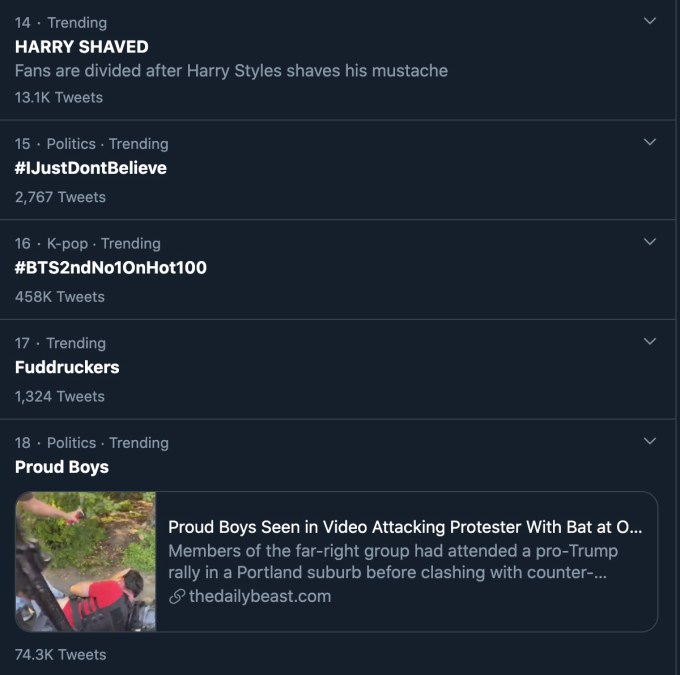Twitter is working to make its real-time Trending section less confusing. Last week, the company announced it would begin pinning a representative tweet that gives more insight about a trend to the trend’s page and promised more changes would soon be underway. Today, the company says it will begin writing headlines and descriptions for some of the trends, too, so you’ll better understand why something is showing up in the Explore tab or when you tap into a trend itself.
Combined, these changes could have made Twitter’s Trending section feel more like a newsreader experience, had they been properly and fully rolled out across the Trends product.
For example, instead of only seeing that the rapper “Travis Scott” is trending at No. 1, as he is as of the time writing, Twitter now explains by way of a headline and short summary that he’s trending because his menu collaboration with McDonald’s has just launched. That’s helpful — especially because a celebrity’s name often trends when they’ve passed away or said something outrageous.
Unfortunately, Twitter’s ability to properly annotate its trends is still lacking, despite its recent updates.
There are a number of trends that will still offer no explanation — in particular, those that are led with a hashtag, like today’s #IJustDontBelieve, where users are tweeting about what they don’t believe by filling in the rest of the tweet with their own opinions. The long hashtag #BTS2ndNo1ONHot100, which is driven by fans of the KPop group, BTS, is also left unannotated. For newcomers unfamiliar with how BTS fans heavily use Twitter or the popularity of Twitter’s fill-the-blank memes, these sorts of trends could be confusing.
In other cases where a trend is unannotated, Twitter lets a news headline do the work of adding context.
Often, several of the top trends will be focused on news items of the day. But instead of a summary and headline provided by Twitter, you’ll find a representative news headline link listed alongside the trend instead.

Image Credits: Twitter screenshot by TechCrunch
“Proud Boys,” for example, is the No. 17 trend in the U.S. as of the time of writing. But Twitter only links to an article on the site Daily Beast that references a violent clash between the far-right Proud Boys and protestors. It doesn’t tackle trying to explain why this particular article, detailing one of now many incidents of violence across the U.S., is trending. Users, presumably, are meant to infer that the article itself is getting a lot of attention. But in reality, Twitter users are tweeting a variety of content under the “Proud Boys” trend, including their own videos of violent attacks and standoffs.
In this way, Twitter is doing a disservice by pointing only to a single news article when, people aren’t necessarily talking about the article itself — they’re sharing direct footage of what they witnessed or their opinions about the increasing violence in general.
Twitter, meanwhile, has put its curation team to work to summarize less important news, like a trend about Harry Styles’ new look.
Currently, Twitter’s Trending section in the U.S. features a list of 29 trends, but only around a half dozen have a headline or description written by Twitter, at the moment.
Twitter had said when announcing the changes last week that the descriptions written by its curation team aim to provide straightforward, clearly sourced context around why something is trending on “some” tweets.
What’s not been clear, however, is how Twitter has been picking and choosing which trends to annotate.
Twitter, in theory, could have provided a lot more context around its trends, if it had invested more heavily in the product. There are third-party Twitter API partners that can generate data like when a trend is breaking, the velocity and number of tweets it’s seeing, the social sentiment around the trend, the location tweets are being generated from, and much more. But this sort of data isn’t available directly on Twitter.
Asked why only some of its trends have Twitter-provided explanations, a Twitter spokesperson explained that Twitter will annotate only those trends it believes needs the extra information.
“If a trend is particularly confusing and a lot of people are talking about it, it may get a pinned Tweet or a description,” the spokesperson says. That means Twitter is making editorial decisions to provide less context at times when it’s needed the most.
If, for example, a majority of tweets about a protest were either in support of or in horror of said event, Twitter’s ability to contextual that trend with data would be incredibly useful. But it’s not taking on those sorts of difficult challenges, it seems.
The spokesperson added that Twitter hopes to add more context to more trends over time.




